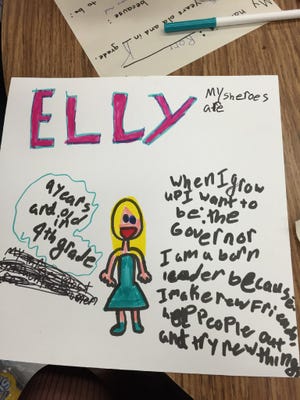How to teach a girl to lead: Montana state legislator
'You made me feel special,' an 8-year-old said. 'I am going to run for office too, just like you!'
There are some similarities between speaking in front of the Montana State Legislature and speaking in front of a room full of 6-year-olds. You must come armed with knowledge and a clear message. It takes confidence and a bit of showmanship to keep everyone’s attention.

Last year, when I stood in front of a class of 10 girls at Lewis and Clark Elementary School in Missoula, I brought a book called Grace for President. It tells the story of a little girl who learns that there has never been a female president and decides to become the first. I don’t mind saying, it’s an inspiring story for all ages.
Each year, the Center for American Women and Politics at Rutgers University sends a children’s book about inclusive leadership to every female legislator, member of Congress and governor in the United States. They ask that we visit a local elementary school, read the book, talk about our experiences as elected officials, and donate the book to the school library. The goal of TAG, the Teach a Girl to Lead program, is simple: by being present and visible in the classroom, even for a day, women elected officials like me can encourage young girls to follow in our footsteps.
I spent that afternoon with the students of Lewis and Clark Elementary talking about what leadership means and — more importantly — what it looks like. I came back the next week with three of my fellow women leaders in our local government. We all talked about what running for and holding elected office is like. We discussed how government and the Electoral College work, and the importance of voting.
A few weeks later, I received a crayoned picture and a note from an 8-year-old girl that read, “You made me feel special. I am going to run for office too, just like you!”
Sheryl Sandberg: Pay gap holds us all back
In their earliest years, when their ideas about the world are first formed, children study the Founding Fathers and discover the stories behind major milestones of American history — Christopher Columbus, Abraham Lincoln, Martin Luther King Jr. Boys grow up seeing powerful public leaders who look like them. Rarely are young girls given the same example. Women figure poorly into our country’s historical narrative, often reduced to wives or daughters. No national holiday honors the accomplishments of a woman.
Women have achieved success as leaders in almost every sector of our society, but we remain underrepresented in elected office. Even though we make up more than half of the population, women hold less than a quarter of our nation’s public leadership positions. We volunteer and vote at higher rates than men, but don’t seek elected office at the same rate.
As Marion Wright Edelman said, kids can’t be what they can’t see. Research shows that simply hanging a picture of a woman leader in a classroom improves the performance of girls, changing the way they think about their place in the world. Imagine the impact of deploying real women leaders in the classroom.
When I was a young girl growing up in Idaho, I met the state’s First Lady, Bethine Church, who was visiting our school. Later, in a children’s book filled with color pictures, I learned about Sandra Day O’Connor, our first woman on the United States Supreme Court, and Dorothy Day, who was a fearless social activist for poor people without a voice. These memories profoundly influenced me to become an attorney and run for office.
POLICING THE USA: A look at race, justice, media
The truth about white working-class men: Jill Filipovic
I’m lucky to have been able to look up to the women who came before me. And I’m grateful that they encouraged me, on more than one occasion, to run for office. Today, I am a girl who leads.
This year, TAG’s book selection is called If I Were President. The story introduces readers to the presidency by showing a diverse group of children taking turns carrying out presidential duties. I returned to Lewis and Clark Elementary this year very excited to share this story. We talked and drew pictures of our “sheroes”— our female heroes. They included everyone from Hillary Clinton to Taylor Swift to their mothers, grandmothers and aunts. We talked about the qualities of a hero, among them strength and compassion.
Part of me imagined that this year I would be talking to the students about the first female president. Whether Carly Fiorina or Hillary Clinton, 2016 was the first time I ever truly considered the possibility that a woman would one day lead our country. Seeing all the women’s marches that followed the election, I can’t help but feel that now, the imperative to break that glass ceiling is greater than ever.
All young people need to be encouraged to take an active role in our democracy. I'm looking forward to serving in Helena one day with some of the girls I meet at Lewis and Clark Elementary School.
Ellie Hill Smith is an attorney and a mom serving her fourth term in the Montana House of Representatives.
You can read diverse opinions from our Board of Contributors and other writers on the Opinion front page, on Twitter @USATOpinion and in our daily Opinion newsletter. To submit a letter, comment or column, check our submission guidelines.